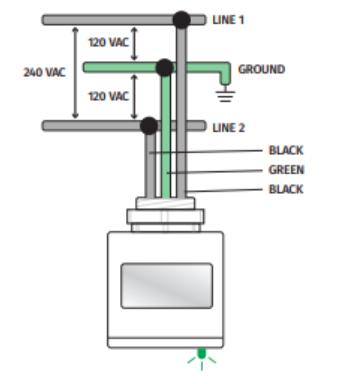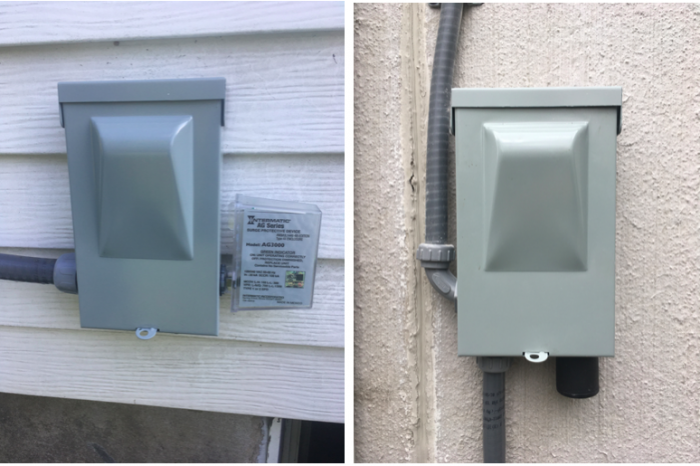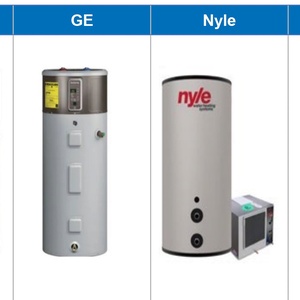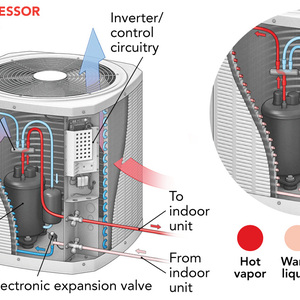
Modern cold-climate heat pumps are packed with sophisticated electronics. Their boards contain power-control circuits that change alternating current into variable-frequency direct-current signals, allowing compressors to speed up or slow down in response to heating or cooling demand. Sensors and microprocessors also coordinate the operation of the compressor, indoor and outdoor fans, and refrigerant metering valves, optimizing the system across a wide range of indoor and outdoor conditions.
These microprocessors and circuit boards, so critical to the operation of cold-climate heat pumps, are also their Achilles’s heel. The electronics can be damaged or destroyed by power surges, either in a single catastrophic event or gradually through a series of low-level surges. The damage can render a system inoperable. A fried circuit board can’t be repaired; it needs to be replaced.
Fortunately, it’s easy and inexpensive to add surge protection to a heat-pump system. This article reviews causes of power surges, explains how surge-protection devices work, and discusses installation, service, and sales of HVAC surge protectors.
Causes of power surges
Residential heat pumps typically operate at an incoming voltage of 230−240V. Power surges are transient spikes during which voltage may exceed 1000V. Though short in duration (usually less than 30 microseconds), they have the potential to cause great damage. Some power surges are caused by lightning strikes; a massive discharge from cloud to earth travels through power lines and damp ground and can impact sites up to ½ mi. away. Other surges occur during utility events, as when grid operators switch between generation sources or reroute power around downed transmission lines. But more than 50% of power surges originate within the home itself. These surges, while less intense than those caused by lightning, are much more frequent, and occur when large appliances turn on and off. These internal surges are caused by arcing when switches open and close and by back electromotive force (EMF) that discharges when motors are de-energized.
A fundamental law of electricity
Both the damage caused by power surges and the operation of a surge protector can be understood in terms of a fundamental law of electricity. Ohm’s Law states that potential (V, in volts) equals resistance (R, in ohms) times current (I, in amperes). If we solve for current, we see that I = V/R. If we increase the potential (V) across a circuit path, the current through it (I) will increase. In the case of a power surge, a brief but dramatic spike in voltage can cause a sharp increase in the current flowing through circuit boards. This increased current overheats sensitive components, which can melt or burn out.
How surge protectors work
Surge protectors work by shunting current away from the appliance and into the ground. The most common type of HVAC surge protectors uses metal oxide varistors (MOVs) to control this flow. Varistors, as their name suggests, are devices whose resistance varies depending on the voltage applied across them. Below their “clamping voltage” (the amount of voltage a surge protector permits to pass through it to the attached load), varistors exhibit very high resistance, but once that threshold voltage is exceeded, their resistance drops.
In a single-phase, 240V HVAC system, the surge protector is connected to the two “hot” voltage legs, L1 and L2, and to the ground terminal. Under normal conditions, the surge protector allows only the tiniest amount of current to trickle to ground. But when a spike in voltage occurs, resistance drops almost instantaneously. In accordance with Ohm’s Law, the surge current flows safely along the low-resistance path, away from the equipment and into the ground. The threshold for HVAC surge protectors is typically set around 150V per leg relative to ground or 300V between the two legs.

Each time an MOV shunts a surge to ground, its performance degrades, and its clamping voltage decreases. This can happen suddenly in a single massive surge or more gradually over a series of low-level events. Left unchecked, an MOV’s clamping voltage will eventually fall below the normal line voltage. At this point, the surge protector can become a short circuit to ground; the flow of current through wires and terminals can lead to overheating, and, potentially, a fire.
Modern MOV surge protectors contain a fuse that breaks the circuit path when the clamping voltage decreases to unsafe levels. These are labelled “tpMOV” or “tfMOV” (thermally protected or thermally fused metal oxide varistors). The fuse prevents overheating, but it also renders the surge protector inoperable. Many surge protectors contain LEDs that go out to indicate that the device has failed. The fuse does not interrupt power to the heat pump itself, which will continue to operate without surge protection.
Some HVAC surge protectors, like the Rectorseal RSH-50, incorporate a second variable-resistance device, the gas discharge tube (GDT). A GDT is a small sealed vessel containing an inert gas. When high voltage is applied across its electrodes, the gas ionizes and becomes capable of conducting large currents. Unlike MOVs, whose clamping voltage decreases over time, the voltage that triggers a gas discharge tube increases with repeated surges, eventually reaching a point at which the device no longer provides protection against any but the highest voltage events. A surge protector that contains both an MOV and a GDT takes advantage of the strengths of each: the MOV provides a rapid response to an incoming surge, while the high-flow path provided by the GDT slows the degradation of the MOV and extends the useful life of the device.
HVAC surge protectors are designed to protect a single circuit—the heat pump. A provision in the 2020 National Electrical Code (NEC 230.67) requires installation of whole-house surge protection in new homes and when electrical service is upgraded or replaced. Will this requirement make HVAC-specific devices unnecessary? The short answer is no. Surge protection at the main panel may not protect against surges that originate within the home. And, because all surge-protection devices are limited, both in their life expectancy and their ability to mitigate large surges, a “belt and suspenders” approach offers a higher level of protection for HVAC equipment.
What surge protectors can’t do
Surge protections are designed to prevent damage from transient spikes in voltage, but they do have their limits. No device on the market can protect against a direct lightning strike. It’s also important to note that surge protectors are not designed to address persistent over-voltage caused by a poorly regulated grid. One manufacturer’s training states that ongoing grid voltages above 253 volts can lead to circuit board failures. Issues with grid overvoltage are best addressed with the utility. Failing this, a buck-boost transformer can be installed on the HVAC circuit to bring the line voltage into the acceptable range.
Installation details
HVAC surge protectors are typically installed on the outdoor disconnect. With the power to the circuit shut off at the panel, the disconnect is opened up, and a knockout is removed from the bottom or side. The surge protector’s wires and a threaded nipple are fed through the knockout, and the device is secured with a locknut. The two black wires are connected to the incoming line terminals, and the green wire is connected to the ground lug. The disconnect is closed up and the circuit re-energized. The entire process takes less than 15 minutes.
Surge protectors are essentially maintenance-free. Homeowners should be instructed to monitor the indicator LED to make sure the device is still active and to call for replacement should the LED go out. Service techs should also check surge protectors as part of preventive maintenance. To avoid damage to equipment, worn-out surge protectors should be replaced promptly.

Adding surge protection to your services
Surge protectors offer benefits to both the customer and the contractor. For the homeowner, they reduce the possibility of an unplanned—and potentially costly—repair and an extended period without primary heat or air conditioning. In addition, several manufacturers of surge protectors offer a warranty covering damage to connected HVAC equipment.
For the contractor, surge protection represents an easy and profitable add-on that reduces the likelihood of an annoying callback. Diagnosing and replacing a fried circuit board requires two trips under the pressure of a no-heat or no-cool situation, along with time spent on the phone with tech support. Every tech and business owner I know would much rather be spending their time on more rewarding activities.
Surge protection can be offered as part of a new installation or at a service call or preventive maintenance visit. Our company made the decision to make it a standard feature of every new heat pump installation. We believe it’s the right thing to do. While it adds a modest up-front expense, it can prevent much larger headaches down the road. Discussing the value of surge protection with customers gives us a chance to differentiate our company and demonstrate our commitment to a high-quality, long-lasting installation. _________________________________________________________________________
-Jon Harrod is founder of Snug Planet, a contracting company in Ithaca, N.Y., whose mission is to reduce building energy use in ways that make sense for people and the planet. Jon holds multiple certifications from the Building Performance Institute and has published numerous articles on energy efficiency and green building. Photos courtesy of author, except where noted.
Weekly Newsletter
Get building science and energy efficiency advice, plus special offers, in your inbox.














16 Comments
I'm aware of two manufacturers of inverter based equipment that had high failure rates without surge suppressors. So highly recommended. Cost for the device itself can be < $100.
IMO, one should also reduce indirect "ground potential rise" lighting damage risk by not creating a conductive path directly from the outdoor equipment to earth ground. Ie, the single point earth ground near the panel should be the only ground path.
A second (or more) ground rod is fine as long as all grounds are bonded together and to the service entry ground.
"It’s also important to note that surge protectors are not designed to address persistent over-voltage caused by a poorly regulated grid."
Is there instrumentation one can install to determine the quality of incoming current from the grid, in order to plan for corrective measures if needed? Ours is a rural property with a dodgy utility, and it stands to reason there'll be a higher risk of poor quality current as a consequence.
I use Sense & feel the pros outweigh the cons by 'enough'. Each leg's voltage is monitored & recently a Power Quality logging of dips & spikes was added in the 'Labs' section. L1 has gone to 109V, L2 119V so I'll be contacting my utility. Hot water heat pump has been working fine for a couple of years & we're installing a Spacepak air to water HP on hydronic soon. So, more power quality sensitive equipment.
https://community.sense.com/c/sense-labs/35
As Chris mentioned, a “Sense” monitor is one way to go. Another company makes a product called “Ting” that simply plugs into a receptacle and provides similar power quality data (our’s was free by way of our home insurance provider - State Farm)
That's something I had not thought of. Would you recommend an equipment pad made of plastic or other nonconductive material between the outdoor unit and the ground?
Yes, I'd look for electrical isolation, sound isolation (ie, don't mount to house) and height above snow. What is available that meets all three? Perhaps a treated wood or metal frame with electrically insulated standoffs to attach the unit?
There is another type of power protection that works by disconnecting the power (with a relay) whenever the power is out of spec. My experience (admittedly with other electronic equipment) is that adding these to the type discussed above provides a significant reduction in problems.
One product I'm aware of is the Intermatic "Compressor Defender." This appears to be intended mainly for non-inverter heat pumps with 24V controls. In addition to acting as a surge protector, it interrupts the 24V signal (shutting down the compressor) in the case of undervoltage (brownout). It includes a time delay to prevent frequent cycling during brownouts.
Sounds similar, although not clear that it fully detaches the device circuitry from the line. This one does.
https://www.grainger.com/product/5KPX9
I have a surge protector at the panel but was under the impression that it won't do much for the regular fluctuations that can degrade circuits over time. (And nothing stops nearby lightening strikes) To address this issue, I thought you needed some type of regenerator that could condition the incoming feed and deliver clean power. Does such a thing exist for the residential market in a whole-house package? Just wondering...
A modern variable speed compressor drive system actually has something like you are describing built into it--the motor isn't run on the line voltage, but on an ac waveform that's generated by the "inverter" or "variable speed drive" that is part of that system. A regular line-voltage ac motor compressor can get stressed during a brownout, with the motor nearly or actually stalling and drawing a lot of current, but an inverter drive won't do that to the motor. The flip side is that the power electronics used in the inverters are more susceptible to spikes than motors running directly on the line.
Conclusion: brown-out protection is useful for basic systems without true variable speed motors, but surge protection is more important for stuff with modern inverter-drive systems.
I have found that a timed disconnect device helps electronics because there is a high correlation between a power line problem and more power line problems. So the MOV surge suppressor and the protected device take fewer hits.
Makes sense--it's the surge right after the brownout, not the brownout, that causes the damage.
I agree that this is a good idea, even if you have surge protection for the whole house at the panel. In addition to the points mentioned in the article, the extra impedance of the line from the panel to the disconnect helps the second surge protector control the spike better than a single-point surge protector.
A good manufacturer will include good surge protection in the equipment, but the key advantage of adding an external one is the monitoring light, so you know when it's been used up by too many surges.
I just installed a surge protector on the main panel in the house, but My HVAC still quits cooling during power spikes during lightning strikes. It runs but does my cool until I flip off the breakers for a while. Do I need a separate surge device for the A/C breaker on the outside of the house?
Log in or create an account to post a comment.
Sign up Log in